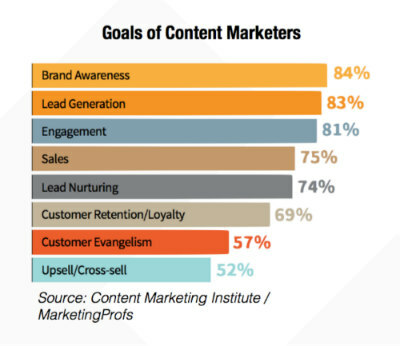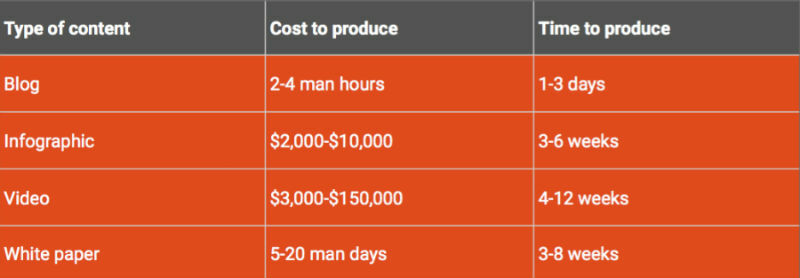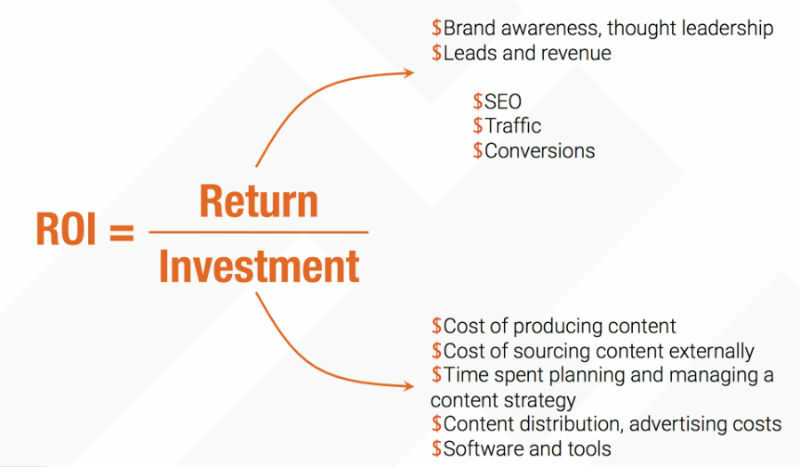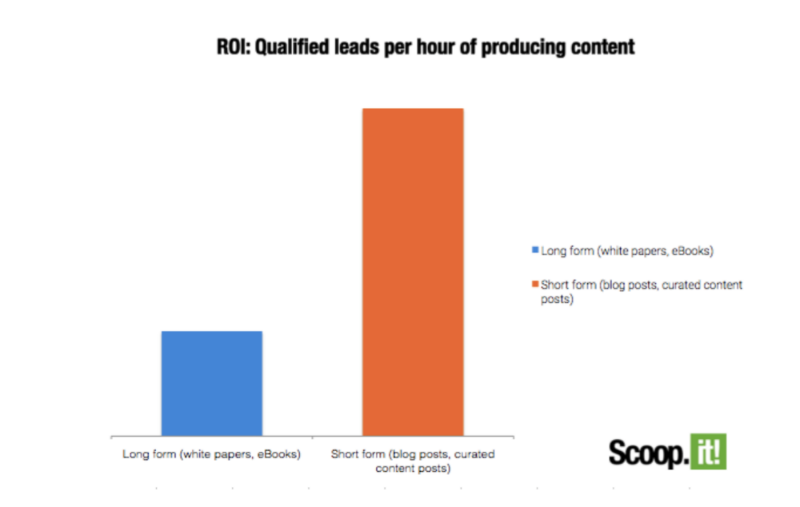This week we were privileged to partner with Scoop.it on a webinar to discuss content marketing return on investment (ROI). Their CEO Guillaume Decugis shared his views and tips for maximizing the returns on your content investment. His advice has made us rethink our own content strategy. This is what we took away, along with our own thoughts on content marketing ROI.
1. Be clear on your goals
Content can be used to support many different aspects of marketing. For example, content can:
- drive awareness
- engage audiences
- generate leads
- convert sales
- nurture prospects and clients
Being clear on your goals is an important starting point. For any content initiative it is good to understand your objectives. You also need to understand the stage of the sales funnel you are looking to support with your content.
According to the latest study from the Content Marketing Institute the most common goals of content marketers are as follows.
2. Content is an investment
Content marketing costs money. It may sound obvious, but there is a significant cost to producing high quality, unique content on a regular basis. In some organisations staff are not required to record their time, and hence the real costs of producing content are lost or not quantified. TheScoop.it table below provides a guide to the costs of generating different forms of content.
These costs will vary depending on the content. We find a well researched post can take over 10 hours of time when you include the research, production of charts and images, and the writing and editing of the post.
Given these costs it is important to track content performance and assess your return on investment (ROI). This allows you to develop a content strategy that maximizes your returns.
3. What is ROI?
The return on your investment is simply the value of the goals you achieve relative to the costs of your content investment. Guillaume summarises it as follows:
You have to balance cost of investment against the returns. The returns to measure will depend upon the content marketing ROI goal. For example, driving brand awareness is very different from driving sales conversions. Typical measures are mentions, shares, links, visitor traffic, leads and conversions.
A good understanding of your returns relative to the investment cost can help your strategic decision making. A common mistake is to just look at the returns and ignore costs. For example a well researched white paper may generate the most leads overall but it may not create more leads per hour of investment in the content. In the case of Scoop.it they found that white papers and ebooks generated less leads relative to the cost of investment than short form and curated content. This can be seen below.
Interestingly in our BuzzSumo experience we have found that well researched and long form content can be more cost-effective than shorter forms of content and drive significantly more leads. Though you need to keep in mind that ROI is measured over time, and long form content is more likely to be evergreen than short posts. So over the longer term you’d expect to see long form contribute more ROI.
4. Research and Plan
One mistake we see a lot is rushing into content production without enough research. Researching the content that resonates with your audience helps take away the guesswork about the content you should be producing. One simple way to do this is to search for the most shared content on your topics on BuzzSumo. You can also enter the domains of your competitors to see what is working best for them.
Guillaume stresses the importance of understanding and answering the questions your audience is asking. We particularly like Lee Odden’s advice that your content should be the best answer to a question your audience is asking. We would suggest you search for the most shared posts in your topic area and assess how you can improve upon those posts. If you can’t, then look at other areas and topics where you can be the best answer.
Given you will have a limited budget to invest in content, you will need to consider the balance of quality v quantity. Do you produce a lot of average articles or fewer higher quality pieces of content? Hubspot research suggests that publishing more regular content generates more leads as shown below.
This suggests you need to produce a minimum level of regular content. Scoop.it publish three posts each week, in the case of BuzzSumo we publish just one post a week. We have typically focused on longer research driven posts that provide unique insights rather than more content. However Guillaume has made us think about ways in which we can increase our content production through curation and repurposing, as set out below.
When planning your content schedule, we think it is important to include evergreen content. This is content that has longevity and can create a compounding return on your investment over many years. By contrast a newsjacking post on a recent development may have a very limited life span.
Whatever your content plan you need to schedule and manage the process. This doesn’t have to be complex if you are not producing lots of content. At BuzzSumo we currently use a Google doc that sets out what we are doing each week over the next three months. Scoop.it use their own Content Director tool to plan, source and schedule their content and this is something we are now looking to use at BuzzSumo.
5. Have an efficient content production process
One way to maximise your returns is to reduce your investment costs by being more efficient in your content creation. Guillaume suggested many practical ways that you can be more efficient at content production, for example:
- curated content
- repurposed content
- co-creating content
Content curation
Guillaume made a strong case for content curation as this may help you produce more content consistently at lower cost. It is hard work researching and producing original content and curation can help you. This can take a number of forms, for example:
- Curated social sharing
- Curated posts
- Curated emails
You need to make your curated content unique and helpful. The very fact you are curating means you are being helpful and doing the heavy lifting for your audience. Provide a summary of the key points, so that your audience can decide if that is all they need or if they want to delve deeper. You can also provide links to related articles so they can go deeper if they need to.
One important aspect is that as a curator you should provide a commentary and your personal viewpoint, this helps make your curation unique and original.
Repurposing content
Repurposing can help you produce more content. For example, you can take the slides from a webinar and repurpose them for Slideshare. You could also write up a webinar as a blog post as I am doing here. Both are efficient ways to create more regular content.
Co-creating content
Working with partners to co-create content has many benefits. It means the content production task is shared. It also means you can improve your content amplification by leveraging the audiences of both parties.
Content Hub
You can use a content hub if curation is a key part of your strategy. This is how scoop.it organize their content.
6. Distribute and Amplify
Last year we undertook a survey of over 1m articles. We were surprised to find that 50% of content articles received 8 shares or less. We believe that this is in part due to poor distribution and amplification.
Before you even write your content you need to consider who will help you distribute and amplify it. Who will share your content on their social networks and who will link to your content? In simple terms you need a distribution and amplification strategy to generate maximum content marketing ROI.
In our view you need to invest as much time and money in distribution and amplification as you do in content creation. Producing your content is just half of the battle.
Your amplification strategy can include a range of approaches from paid promotion to influencer marketing. We have previously set out our approach to influencer marketing which is supported by our new BuzzSumo outreach lists and engagement tools.
You should also regularly share and reshare your content on social networks, particularly evergreen content. This can be made more efficient by using scheduling tools such as Content Director, Agorapulse and Buffer amongst others.
7. Analyze
The final part of the Content Marketing ROI process is analyzing your returns. At Scoop.it Guillaume tracks the performance of every piece of content, including leads and conversions. A conversion is not necessarily a sales conversion but a next step, such as subscribing to an email list or downloading gated content.
By tracking and reviewing the performance of each piece of content you can make informed decisions on your content plan. It can be dangerous to make assumptions. For example you can’t assume that because short form content delivers the best returns for Scoop.it that it will equally deliver the best returns for your own content investment. You need to undertake your own analysis and analyze what works best in your industry and with your audience.
Categories
Content MarketingCategories
Content MarketingThe Monthly Buzz⚡
Subscribe to BuzzSumo's monthly newsletter to:
Stay up-to-date with the best of the best in content marketing 📝
Get data-informed content, tips and tidbits insights first 👩🏻💻
Read top shared content by top marketing geeks 🤓
Try
Enter any topic, term or url to search to see BuzzSumo in action. It’s free!
100% free. No credit card required.






